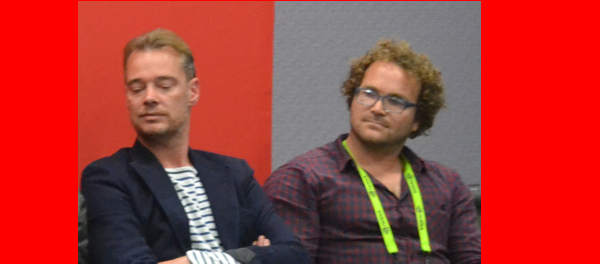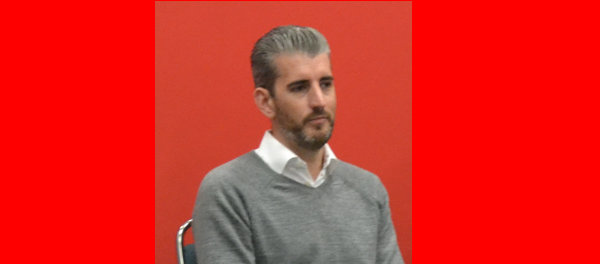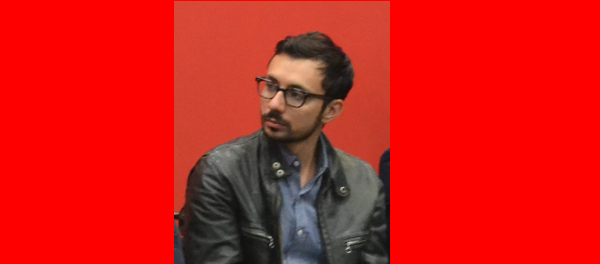
by Lidia Paulinska | Sep 1, 2015
August 2015, Siggraph – Two panelists came from Amsterdam to attend Siggraph 2015 and at the Lenovo’s panel share discussion about their new project. Tim Geurtjens and Gijs Van Der Velden are co-founders of MX3D, a company researching and developing groundbreaking robotic 3D printing technology. They developed 3D large scale printers that allowed printing large structures and different materials including plastic, stainless steel and aluminum. Tim and Gijs recently came up with an ambitious plan to build a steel bridge over the canal in Amsterdam. Geurtjens confessed that idea of building a bridge using 3-D printing techniques started with frustration about the 3D printing market. “We use 3D printers all the time, but they make only the small parts. We asked the companies that manufacture 3-D printers to develop printers for large parts but the companies were not interested in developing them” said Guertjens, “so we decided to do it on our own.”
Tim and Gijs discussed their plan to build a 3D printed steel bridge over the canal in Amsterdam. “We want to show the world what that technique could do”. The founders of MX3D are getting government support for this project as the city officials are really interested in presenting Amsterdam as an innovative and progressive city. Even though they invented the technology, they estimate that it will take them a year to understand fully, the capacity and the limits of their technology in an outdoor application and do a design. The starting date is set for spring 2017 and with an estimate to take 3-4 months to print the bridge. The most interesting thing about this 3-D image technique is that we can not only print the building as a new object, but we can use the multi-robots in the system to build in place from an existing structure. In that case, the projects can be of unlimited size” said Geutjens.
Using these 3D printing techniques, it is possible to recreate things. Geurtjens sees the printers as an extension of the existing techniques. Currently, there is a Chinese company that is us using additive manufacturing to print buildings, but it is more efficient and most appreciated, if we use the technology to create additional decorative pieces. It is well known that decoration is the heart of architecture. The use of computers and printers allows these designs to be extravagant, as it does not matter how complex the pieces are. Why use traditional techniques if we can add to them with the time and money consuming details?

by Lidia Paulinska | Sep 1, 2015
August 2015, Siggraph – Chris Edwards is the Founder and CEO of The Third Floor, the world’s leading pre-visualization studio services up to 40 major studio feature films each year. He is also Co-Founder/CEO of The VR Company. In addition to the two companies, he has extended his qualifications into the content area. Over the last 10 years he has been building a massive database of 3D assets, and servicing the world’s top Directors. He began his career in digital cinematography at Disney Studio and then he worked for George Lucas at Skywalker Ranch. His credits include Marvel franchises like Avengers and X-Men, the new Godzilla and Gravity.
“In the previsualization studio, we are working in real time to create scenes ahead of production, so a director can try one and have other options to choose from” said Edwards. . He explained that his company helps incubate concepts and package production for VR. The studio is experimenting with master layer imagery, which is combining CGI with live action photography for VR.
“Every time you go to see the Broadway play you feel like you are transformed by this amazing experience. We need to bring back that kind of language. Before we had cinema”, he continued, “we had a rectangle on the wall to display, dream, and still entertain us. That was called theater or play or some performance. It usually happened in front of the audience. The actors stayed sometimes on the front, or they go around. When you see Cirque du Soleil they come from above. The director uses all the tricks that work: sound design, blocking the characters and how they move around you, and lighting.”

by Lidia Paulinska | Sep 1, 2015
August 2015, Siggraph – David Karlak, a filmmaker based in Los Angeles, sees VR as an extension of the dreams that we have always had. He predicts that beyond VR, there will be additional technologies that will give us more immersive experiences. These experiences will include characteristics and senses from the physical world, such as smell. The opinion of the panel was that VR is not a necessity to be pushing innovation, but it is instead a wish fulfilling technology. For now, access to VR is not affordable to 99% of the world, but over time it will be more popularized and democratized.
Karlak has been exploring the confluence of virtual reality and science fiction cinema. He directed the short film “Candidate” that created a lot of buzz in the industry. Following this success, he raised funds on Kickstarter for his next project “Rise”, a film about a robot revolution in the future, told from the perspective of the robots. He sold the original story concept to Warner Brothers. Soon after sale of “Rise”, he sold a second original pitch titled “Outliers” to 20th Century Fox.
When he talked about VR he reminded the audience about the scene from “Reservoirs Dogs” by Quentin Tarantino. There was a scene in the film where all the characters were sitting on the table and the cameras was on a dolly which was rotating from one character to another. Having that camera calling out the characters in that moment is like having a camera on the table. “It actually make things simpler”, said Karlak . ”There is more emphasis on blocking of your actions in oppose to blocking of the camera. The camera in some ways disappeared leaving the viewer deeply immersed in the dialog and action of the scene.” He sees VR as alternative to Facebook or Instagram. People instead on spending time posting on social media, they will be “physically immersed” and connected in VR.

by Lidia Paulinska | Sep 1, 2015
August 2015, Siggraph – Allen Bolden, CGI artist and visual effects veteran with credits including “Marvel’s The Avengers,” “Iron Man” and other blockbuster productions, agreed that everyone has a dream or story in their head. He recently developed a real time intelligence system named Tina to help those dreams or stories to get out to the screen. He worked on that program for the last 10 years and now gets “textual input, visual output”.
“My team”, explained Allen, “took all those tedious things and put it into this simple program. For example, if we type “bowl on the table”, the software creates a CGI image of a bowl and of a table. The beauty is the more you work with Tina, she learns more about you and your preferences. Tina is an intelligent work companion that is handy and works with us towards our goals. People see things in subjective ways, so the CGI image can be different from what they expected. There is a way to change the image and improve program to make the image the way we like it.



